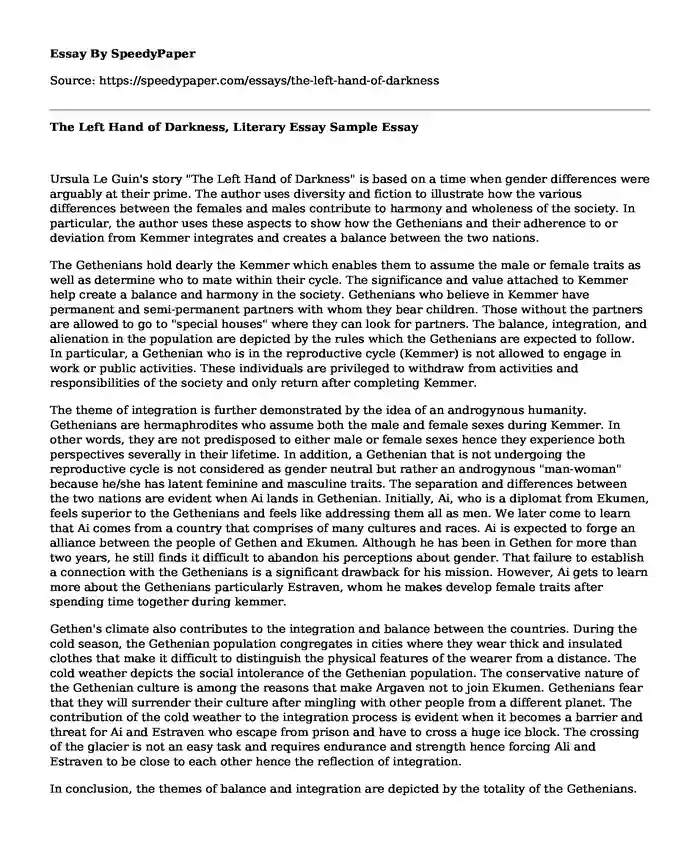
| Type of paper: | Essay |
| Categories: | American literature |
| Pages: | 3 |
| Wordcount: | 668 words |
Ursula Le Guin's story "The Left Hand of Darkness" is based on a time when gender differences were arguably at their prime. The author uses diversity and fiction to illustrate how the various differences between the females and males contribute to harmony and wholeness of the society. In particular, the author uses these aspects to show how the Gethenians and their adherence to or deviation from Kemmer integrates and creates a balance between the two nations.
The Gethenians hold dearly the Kemmer which enables them to assume the male or female traits as well as determine who to mate within their cycle. The significance and value attached to Kemmer help create a balance and harmony in the society. Gethenians who believe in Kemmer have permanent and semi-permanent partners with whom they bear children. Those without the partners are allowed to go to "special houses" where they can look for partners. The balance, integration, and alienation in the population are depicted by the rules which the Gethenians are expected to follow. In particular, a Gethenian who is in the reproductive cycle (Kemmer) is not allowed to engage in work or public activities. These individuals are privileged to withdraw from activities and responsibilities of the society and only return after completing Kemmer.
The theme of integration is further demonstrated by the idea of an androgynous humanity. Gethenians are hermaphrodites who assume both the male and female sexes during Kemmer. In other words, they are not predisposed to either male or female sexes hence they experience both perspectives severally in their lifetime. In addition, a Gethenian that is not undergoing the reproductive cycle is not considered as gender neutral but rather an androgynous "man-woman" because he/she has latent feminine and masculine traits. The separation and differences between the two nations are evident when Ai lands in Gethenian. Initially, Ai, who is a diplomat from Ekumen, feels superior to the Gethenians and feels like addressing them all as men. We later come to learn that Ai comes from a country that comprises of many cultures and races. Ai is expected to forge an alliance between the people of Gethen and Ekumen. Although he has been in Gethen for more than two years, he still finds it difficult to abandon his perceptions about gender. That failure to establish a connection with the Gethenians is a significant drawback for his mission. However, Ai gets to learn more about the Gethenians particularly Estraven, whom he makes develop female traits after spending time together during kemmer.
Gethen's climate also contributes to the integration and balance between the countries. During the cold season, the Gethenian population congregates in cities where they wear thick and insulated clothes that make it difficult to distinguish the physical features of the wearer from a distance. The cold weather depicts the social intolerance of the Gethenian population. The conservative nature of the Gethenian culture is among the reasons that make Argaven not to join Ekumen. Gethenians fear that they will surrender their culture after mingling with other people from a different planet. The contribution of the cold weather to the integration process is evident when it becomes a barrier and threat for Ai and Estraven who escape from prison and have to cross a huge ice block. The crossing of the glacier is not an easy task and requires endurance and strength hence forcing Ali and Estraven to be close to each other hence the reflection of integration.
In conclusion, the themes of balance and integration are depicted by the totality of the Gethenians. Their physical features encompass paradox and motivate them to completeness and integration. Due to their unique physiology, they are able to transform from one sex to another sex in a way an ordinary person cannot. The lack of single-sexed species eliminates the perception that anything different them is separate from them hence the idea of integration and balance in the planet.
Works Cited
Le Guin, Ursula K. The Left Hand of Darkness. New York: Ace Books, 1969.
Cite this page
The Left Hand of Darkness, Literary Essay Sample. (2022, Apr 06). Retrieved from https://speedypaper.net/essays/the-left-hand-of-darkness
Request Removal
If you are the original author of this essay and no longer wish to have it published on the SpeedyPaper website, please click below to request its removal:
- Professional Goals Essay Examples
- Multitasking in the Game Industry. Free Essay on Project Management.
- Free Essay Sample on the Importance of Higher Education in USA
- Toy Company: Free Essay on Its International Market Strategy
- Free Essay about Special Restrictions of Licensing on Young Drivers
- Essay Sample on Starbuck's Foreign Entry Strategy
- Paper Example. An Analysis of Love and Friendship by Emily Bronte
Popular categories




